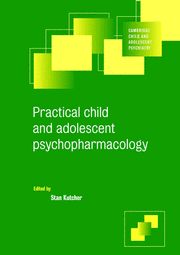Book contents
- Frontmatter
- Contents
- List of contributors
- Preface and acknowledgements
- 1 Child and adolescent psychopharmacology at the turn of the millennium
- 2 Developmental psychopharmacology
- 3 Clinical aspects of child and adolescent psychopharmacology
- 4 Depression
- 5 Bipolar mood disorders: diagnosis, etiology, and treatment
- 6 Schizophrenia and related psychoses
- 7 Obsessive–compulsive disorder
- 8 Anxiety disorders
- 9 Attention-deficit/hyperactivity disorder
- 10 Pervasive development disorder
- 11 Aggressive behavior
- 12 Adolescent substance use disorder
- 13 Tic disorders and Tourette's syndrome
- 14 Eating disorders and related disturbances
- 15 Medical psychiatric conditions
- Index
10 - Pervasive development disorder
Published online by Cambridge University Press: 31 August 2009
- Frontmatter
- Contents
- List of contributors
- Preface and acknowledgements
- 1 Child and adolescent psychopharmacology at the turn of the millennium
- 2 Developmental psychopharmacology
- 3 Clinical aspects of child and adolescent psychopharmacology
- 4 Depression
- 5 Bipolar mood disorders: diagnosis, etiology, and treatment
- 6 Schizophrenia and related psychoses
- 7 Obsessive–compulsive disorder
- 8 Anxiety disorders
- 9 Attention-deficit/hyperactivity disorder
- 10 Pervasive development disorder
- 11 Aggressive behavior
- 12 Adolescent substance use disorder
- 13 Tic disorders and Tourette's syndrome
- 14 Eating disorders and related disturbances
- 15 Medical psychiatric conditions
- Index
Summary
Introduction
The pervasive developmental disorders (PDDs) are characterized by impairments in socialization, communication, and imagination, and the presence of repetitive and ritualistic behaviors (American Psychiatric Association, DSM-IV, 1994). While these deficit areas echo Kanner's original description of “early infantile autism” (Kanner, 1943), considerable strides have been made over the past 50 years in the diagnostic clarification and categorization of these disorders. A substantial body of neurobiologic and psychologic research has emerged regarding these phenomenologically similar disorders (Cohen et al., 1994).
The PDDs were first included as a separate category in the third edition of the American Psychiatric Association Diagnostic and Statistical Manual (American Psychiatric Association, DSM-III, 1980). Prior to this, the conceptualization of autism as a form of childhood psychosis (Creak, 1963) led to the lumping together of a heterogeneous group of children with impaired emotional relatedness, abnormal perceptual sensitivities, poorly modulated anxiety, and disordered language and sense of personal identity. This group included children with Kanner's autism as well as those children with hallucinations, delusions, and formal thought disorder. Subsequent differentiation of these children by age of onset, clinical course, and family history (Kolvin, 1971) allowed for diagnostically separate entities. In DSM-III, autism was included under the umbrella of the PDD and criteria for the diagnosis of childhood schizophrenia were subsumed with the adult disorder (American Psychiatric Association, DSM-III, 1980).
Keywords
- Type
- Chapter
- Information
- Practical Child and Adolescent Psychopharmacology , pp. 265 - 304Publisher: Cambridge University PressPrint publication year: 2002

